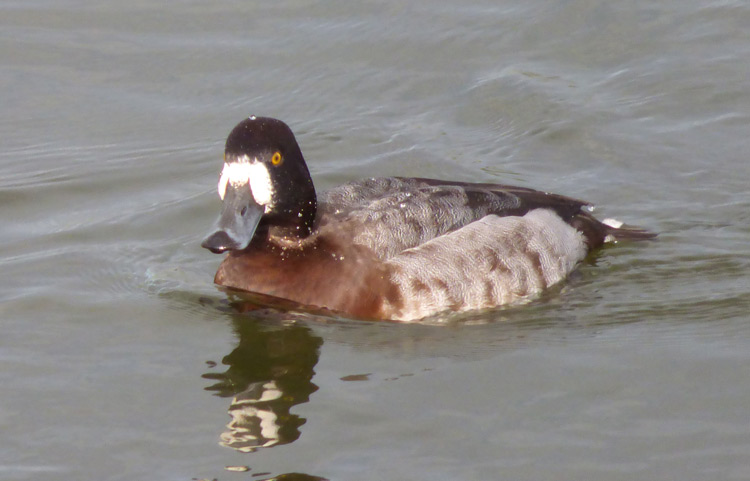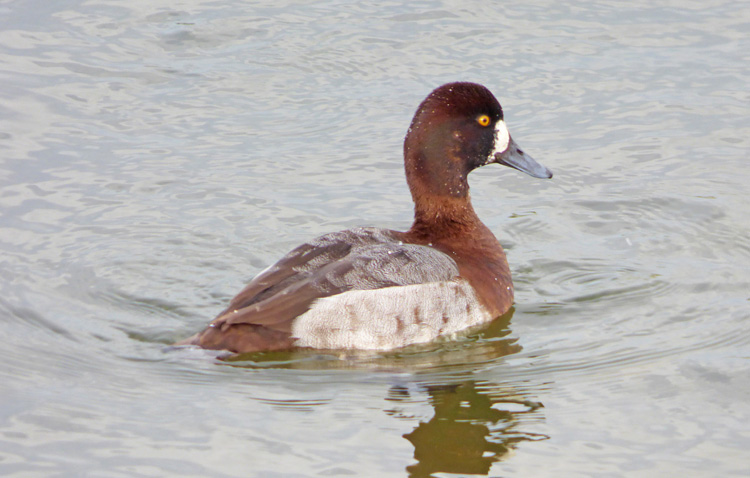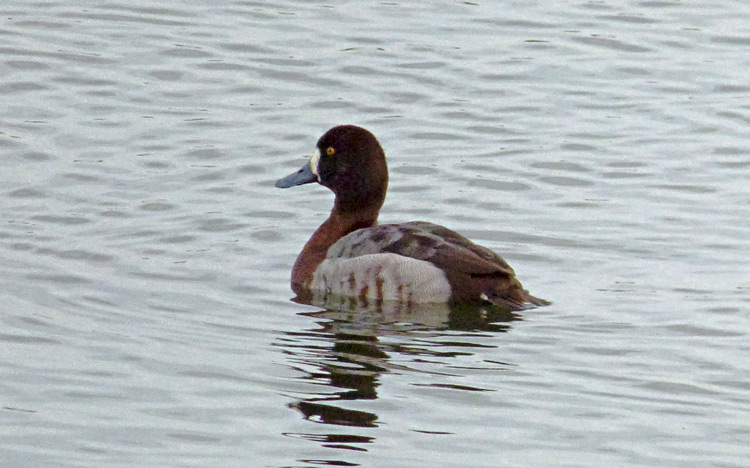Presumed Greater Scaup x Tufted Duck, Warks, January 2016:
Hybrid characters, parentage and underwing pattern
Presumed Greater Scaup x Tufted Duck, Warks, January 2016:Hybrid characters, parentage and underwing pattern |
|
Hybrids between Aythya ducks are not infrequent and can provide an identification challenge. Some are clearly hybrids, with characters intermediate between two species, but others can resemble one of the parent species or, more problematically, they may closely resemble a third and rarer species. The images below portray an intriguing and instructive Aythya at Shustoke Reservoir, Warwickshire, in January 2016. It emerged that what is presumed to be the same individual was observed at the same site during March 2014 which, if so, would make it an adult at least two-and-a-half years old in January 2016 (and just entering at least its fourth calendar year). On both occasions there was debate among observers about the parentage. Majority opinion favoured female Greater Scaup x Tufted Duck (my own eventual conclusion) but there were certainly features of the bird which at times quite strongly recalled Lesser Scaup influence (and other combinations have also been suggested). The publication of a new Helm Identification Guide on wildfowl (Sébastien Reeber, 2015) was timely, therefore, and provided benchmarks against which to review the features of this individual and current thinking on certain key characters.
At longer range and with no nearby species to provide a size comparison, the Shustoke Aythya most readily suggested a female Greater Scaup (my own initial reaction), with coarsely vermiculated 'dingy-grey' upperparts, paler flanks, a smoothly domed head and a prominent white 'blaze' at the base of the bill (plate 1). At closer range, however, it was apparent that it was too small and delicate for Greater Scaup (plate 2) while the crown, while smoothly contoured, was somewhat too low in profile. Also, the tip of the bill appeared too extensively dark (plate 3), with a dark grey wedge fanning out either side of the nail (though in non-adult male Scaups there can be more dark at the bill-tip than is sometimes implied). In conjunction with its relatively small size, extended observations revealed that its appearance could be surprisingly volatile. Not infrequently, it could as well suggest a hybrid involving Lesser Scaup (plates 4 and 5). In 2014, some observers claimed that the wing-bar was duskier on the primaries in comparison with clear white across the secondaries but conclusive evidence of a Lesser Scaup-like upperwing pattern is lacking.
In most circumstances the plumage overall was very scaup-like and provided few clues to a second parent's identity. However, in duller light and especially when viewed from the rear, there were hints of blacker plumage tones and suggestions of Tufted Duck. A little perplexingly, this impression converged with a male Tufted Duck rather than a female (plate 6). This impression was fleeting, however, and seems likely to be a function of 'the angle of incidence' of light under certain circumstances.
In 2002, Martin Garner (always exploring potentially useful identification features) described the underwing pattern of Lesser Scaup (Birding World, 2002, 15: 506 - 508). He noted that: 'The median and lesser underwing-coverts and axillaries of female and immature Lesser Scaup are white and surrounded by grey greater underwing-coverts, grey undersides to the flight feathers (primaries and secondaries) and grey marginal underwing-coverts'. As the distal portions of the greater coverts are rather whiter than the bases, Nils van Duivendijk (Advanced Bird Id Guide, 2010) summarised the pattern as: 'two white bars on grey underwing'. In various texts now, this pattern has been cited as distinct from both Tufted Duck and Greater Scaup, in which the underwing is deemed to appear more uniformly whitish, including on the underside of the flight feathers (e.g. 'off-white overall', Martin Garner BW (2002) 15: 508; 'fairly uniform off-white', Colin Bradshaw BB (2005) 98: 92; 'underwing [of Lesser Scaup] not as all white as on Tufted and Greater', Collins Bird Guide (2009), p46).
Dave Hutton obtained an excellent photo of the underwing of the Shustoke Aythya (plate 7). Comparing this with plates 1 to 3 in the Birding World article shows that they are similar in many respects, with the Shustoke bird showing a white (and even more restricted) panel on the centre of the underwing and framed by grey. The lesser underwing coverts also appear grey though the outer portions of the greater coverts are whiter. The underwing of the Shustoke bird clearly involves 'two white bars on grey underwing' and is clearly not 'off-white overall'.
What of the Helm guide by Sébastien Reeber? In the 'Identification' paragraphs for Greater Scaup, Reeber conveys a similar impression to the earlier texts, saying: 'The underwing coverts are mostly white or pale grey in Greater Scaup, while white is restricted to the median coverts, lower lesser coverts and axillaries in Lesser Scaup (more contrasting underwing, especially in females)'. However, in the text under 'Plumages' he writes: 'Underwing pale grey with tips of greater and median coverts and axillaries white'. This conveys a more marginal difference, an impression also supported by his paintings in Plate 52.
Thus, after consultation of the new Helm guide, the initial thought that the underwing might favour Lesser Scaup input seems more equivocal. Examination of photos on the web supports the conclusion that Greater Scaup, too, can show an underwing pattern matching the Shustoke bird (for example, the Advanced Search facility in Birdguides' photo gallery (Iris) can be used to locate a comparable underwing pattern on a Greater Scaup, photographed by Mike Trew at Slimbridge on 04/12/2015). As noted by Martin Garner, apparent patterns are subject to light conditions. This is an important proviso, yet examination of a number of photos on the web suggests that the underwing patterns of Greater Scaup (female and immature at least) and Lesser Scaup can be rather similar. Certainly, sufficiently similar that any difference is one of degree and will be exceedingly difficult to discern (both in the field and in photos).

© A. R. Dean
Plate 1. Typical appearance, with closest resemblance to female Greater Scaup, though direct comparisons with Tufted Duck showed it to be of similar size and thus distinctly smaller than expected in Greater Scaup. Other anomalies include the rather low (even if smoothly contoured) crown and the extent of dark at the tip of the bill.

© A. R. Dean
Plate 2. At closer range, the relatively slight structure evident. In direct comparison overall size similar to Tufted Duck.
Note, however, the longer, deeper and more wedge-shaped bill with more prominent
flanges and longer and more extruded nail.

© A. R. Dean
Plate 3. Head-on views reveal a dark wedge fanning out extensively from either side
of the nail of the bill, suggesting Tufted Duck influence.
Note the narrow pale 'necklace' which is a feature apparent in various
photos of scaup species.

© A. R. Dean
Plate 4. When on the alert, the head and neck assumed a more slender appearance, with a taller yet narrower head-shape and a narrow and 'willowy' looking neck. In conjunction with relatively small size, the bird in this posture appeared much more reminiscent of Lesser Scaup than Greater Scaup. In this view, even the nail appears as an isolated dark mark at the bill-tip.

© A. R. Dean
Plate 5. In failing light, the plumage looked more 'blotchy' and 'blacker' but here again a Lesser Scaup-like structure is apparent. At all times, however, the crown retained a smooth contour, with no suggestion whatsoever of rudiments of a Tufted Duck crest but no sign either of the discontinuity ('kink') associated with Lesser Scaup.

© A. R. Dean
Plate 6. When viewed from behind the upperparts and the head could appear darker, with a blackish caste to head and enhanced contrast between upperparts and flanks. Although fleeting, and depending upon light and angle of view, the appearance at such times was more indicative of Tufted Duck input while, more confusingly, the bird could appear more like a male than a female!

© Dave Hutton
Plate 7. Underwing pattern of the Shustoke Aythya. Note the white bar on the central underwing formed by the inner median coverts and framed by grey marginal coverts, lesser coverts, bases of the greater coverts and underside of the primaries and secondaries. The terminal portions of the greater coverts are paler, while the axillaries appear steely grey rather than white. See main text for comments.
Thus, the Shustoke bird provides an intriguing example of an Aythya hybrid, with its parentage generating debate locally. It encourages further discussion of the features by which the lineage of hybrids can be evaluated and the consistency of certain features characterising the two scaup species. My own conclusion is that the overall size, the smoothly contoured head profile, and the bill structure and pattern, do indicate Greater Scaup x Tufted Duck. However, this is certainly open to debate, with Lesser Scaup x Tufted Duck difficult to exclude with certainty - though the bill size and shape is arguably too robust for that origin. Variations in underwing patterns warrant further investigation. Clearly, judgement of the origins of such individuals needs to be circumspect and rapid judgements are to be avoided.
Thanks to Steve Haynes and Dave Hutton for discussions. Dave also provided the superb photo of the Shustoke Aythya's underwing.
|
|